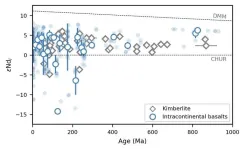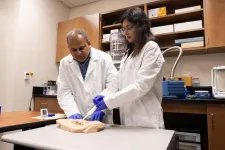(Press-News.org) UNIVERSITY PARK, Pa. — Several medications are available to treat high blood pressure, but more than 10 million Americans do not respond to the treatments, according to the American Heart Association. Using a bioelectronic device to deliver pulsed electricity to the body has proven to be a promising strategy to treat drug-resistant hypertension patients, according to Penn State researcher Tao Zhou, although he noted that its practical application in patient care has significant limitations.
Zhou, assistant professor of engineering science and mechanics and of biomedical engineering, received a five-year, $1.83 million grant from the U.S. National Institutes of Health to develop a soft and stretchable tissue-like electronic device for the treatment of resistant high blood pressure.
In a Q&A with Penn State News, Zhou — who is a co-hire with the Huck Institutes of the Life Sciences and the Materials Research Institute as part of the Center for Neural Engineering — discussed the specifics of the grant.
Q: What are the limitations of existing non-medication-based strategies that treat high blood pressure?
Zhou: Existing devices have significant limitations that precludes their practical application. They are made of stiff materials and unable to stretch in response to the carotid artery wall's periodic expansion and contraction, which can cause tissue damage and inflammation. Devices also must be sutured to the carotid artery wall, which introduces further damage to the tissue on which they were implanted. Overall, these limitations can cause significant patient discomfort, illness and failure of devices over time.
Q: How does electrical stimulation of the neck reduce blood pressure in patients?
Zhou: Electrical stimulation of relevant nerves on the neck can activate the baroreflex, which can modulate patient blood pressure.
Q: What will be the key features of your device, and how will it benefit hypertension patients?
Zhou: We adopt soft and stretchable yet resilient hydrogel-based materials for the fabrication of the devices to better match the mechanical properties of tissues and to reduce tissue damage and inflammation after implantation. Owing to its intrinsic stretchability, the whole device can deform as the artery wall expands and contracts, thus minimizing constraint and damage to the carotid artery. We also will adopt a bioadhesive component in the proposed system to eliminate the need for suturing electrical devices on carotid artery walls, thus significantly decreasing the invasiveness of implanted devices and increasing the safety, stability and functionality of the device.
Q: Who are your collaborators on the grant, and what will they contribute to this work?
Zhou: Collaborators on the grant include John Bisognano, clinical professor of cardiovascular medicine and internal medicine the University of Michigan, and Umar Farooq, associate professor of nephrology at the Penn State College of Medicine. They are experts in resistive hypertension and provide clinically relevant insights on this project.
END
Can electricity treat high blood pressure?
2024-10-16
ELSE PRESS RELEASES FROM THIS DATE:
Microplastics detected in dolphin breath
2024-10-16
U.S. researchers have detected microplastic particles in air exhaled by wild bottlenose dolphins, suggesting that inhalation may be a relevant route of exposure to these potentially harmful contaminants. Miranda Dziobak of the College of Charleston in South Carolina, U.S., and colleagues present these findings in the open-access journal PLOS ONE on October 16, 2024.
Around the world, humans and numerous other animals are exposed to tiny particles of plastic contaminants known as microplastics. In humans and rodents, microplastic exposure has been linked to adverse health impacts, such as oxidative stress and inflammation. Ingestion ...
Global north’s growing appetite for farmed salmon imperils communities’ access to local fish
2024-10-16
A new paper published today in Science Advances exposes the global aquaculture sector’s growing dependence on wild fish. Despite industry claims to the contrary, these findings highlight how the growing appetite for expensive farmed salmon can leave coastal communities struggling to access affordable local fish like sardines and anchovies. Instead, these small pelagic fish are frequently caught, processed, and “reduced” to fishmeal and fish oil, almost all of which is used to feed farmed fish. These ‘reduction fisheries’ account for 26% of global ocean catch.
“As the aquaculture industry grows, so does its ...
e-Flower records neuronal activity with electronic petals
2024-10-16
Neural spheroids — 3D clusters of brain cells — are emerging as essential tools for understanding neural networks and studying neurological diseases in the lab. EPFL’s e-Flower, a flower-shaped 3D microelectrode array (MEA), allows researchers to monitor the electrical activity of these spheroids in a way that was previously impossible. This breakthrough, published in Science Advances, lays the groundwork for more sophisticated research on brain organoids, which are complex, miniaturized models of brain tissues.
“The ...
Aquaculture uses far more wild fish than previously estimated, study finds
2024-10-16
A study published in the journal Science Advances suggests that global fish farming, or aquaculture, may rely on significantly larger quantities of wild-caught ocean fish than previously calculated. The study is part of a special issue focused on expanding contributions from the aquaculture industry to food systems with an aim towards sustainability.
These findings call into question long-held assumptions about the sustainability of the rapidly growing aquaculture industry and provides a range of plausible estimates for its impact on wild fish populations.
The research, led by an international team of scientists ...
Gene editing approach paves the way to first-in-human clinical trial for rare genetic disease
2024-10-16
A collaborative effort between investigators at the National Institutes of Health’s National Institute of Allergy and Infectious Diseases (NIAID) and Massachusetts General Hospital (MGH), a founding member of the Mass General Brigham healthcare system, demonstrates the potential of precise genome editing technologies, called adenine base editors, to correct disease-causing mutations in stem cells from patients with X-linked chronic granulomatous disease (X-CGD), a rare genetic disorder characterized by high susceptibility to infections. The findings are published in Science Translational Medicine.
Patients with ...
Compositional evolution of the upper mantle driven by plate tectonics
2024-10-16
On present-day Earth, plate subduction continuously modifies the chemical composition of the convecting mantle, and various mantle sources linked to these processes have been widely studied.
However, when did global chemical heterogeneity of the convecting mantle first emerge in Earth's geological history? And how might Earth’s geodynamic evolution have influenced the chemical composition of the convecting mantle over time?
Researchers from the Institute of Oceanology of the Chinese Academy of Sciences (IOCAS), along with collaborators from Australia, Switzerland and the USA, have tried to address these questions ...
Virtual reality game used to help students in science classes
2024-10-16
Multilingual students face unique challenges that can hurt their performance in school. New methods of teaching may help close this gap, according to a new study from the University of Georgia.
In the United States, English is the main language used in classrooms. Schools also tend to rely on spoken communication to teach and written exams to assess learning.
That can make it difficult for multilingual students to express themselves. This is especially true in science classes, with their specific terms and complex sentence structures.
So a UGA researcher developed an immersive virtual reality game to communicate scientific ...
Life-saving spongelike “bandage” developed by UCF researchers rapidly stops hemorrhaging and mitigates risk of infection
2024-10-16
Video available here.
Without proper medical invention, injuries sustained from traffic collisions, serious workplace accidents or weapons may result in fatal hemorrhaging.
University of Central Florida researchers aim to prevent such bleeding in potentially deadly situations with a new hemostatic spongelike bandage with antimicrobial efficacy that they recently developed and detailed in a newly published study in the journal Biomaterials Science.
“What happens in the field or during an accident is due to heavy bleeding, patients can die,” says Kausik Mukhopadhyay, assistant professor of materials ...
Model reveals why debunking election misinformation often doesn’t work
2024-10-16
When an election result is disputed, people who are skeptical about the outcome may be swayed by figures of authority who come down on one side or the other. Those figures can be independent monitors, political figures, or news organizations. However, these “debunking” efforts don’t always have the desired effect, and in some cases, they can lead people to cling more tightly to their original position.
Neuroscientists and political scientists at MIT and the University of California at Berkeley have now ...
Project to integrate human and machine intelligence to address information integrity
2024-10-16
Identifying whether online information is faulty or ungrounded is important to ensure information integrity and a well-informed public. This was especially challenging during the COVID-19 pandemic when misinformation spread like wildfire across the Internet. A new project led by Dong Wang, associate professor in the School of Information Sciences at the University of Illinois Urbana-Champaign, will integrate diverse human and machine intelligence to examine multimodal data (e.g., text and image) that was produced during the pandemic. ...






